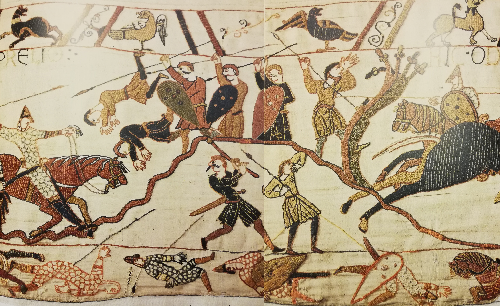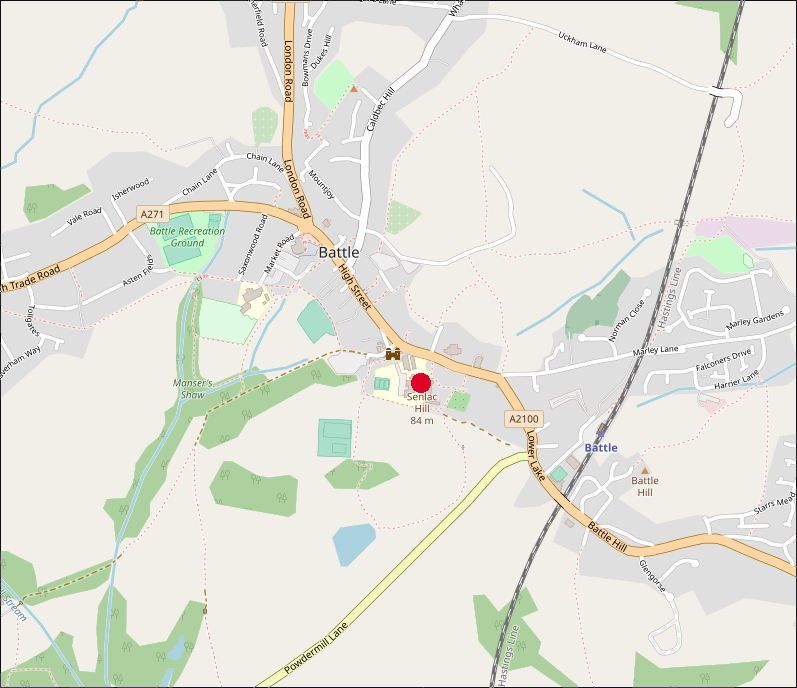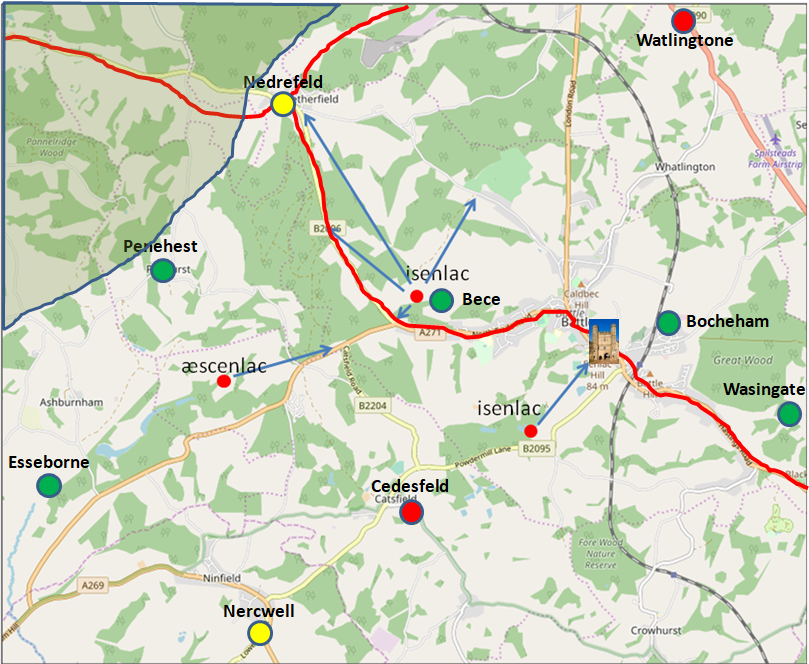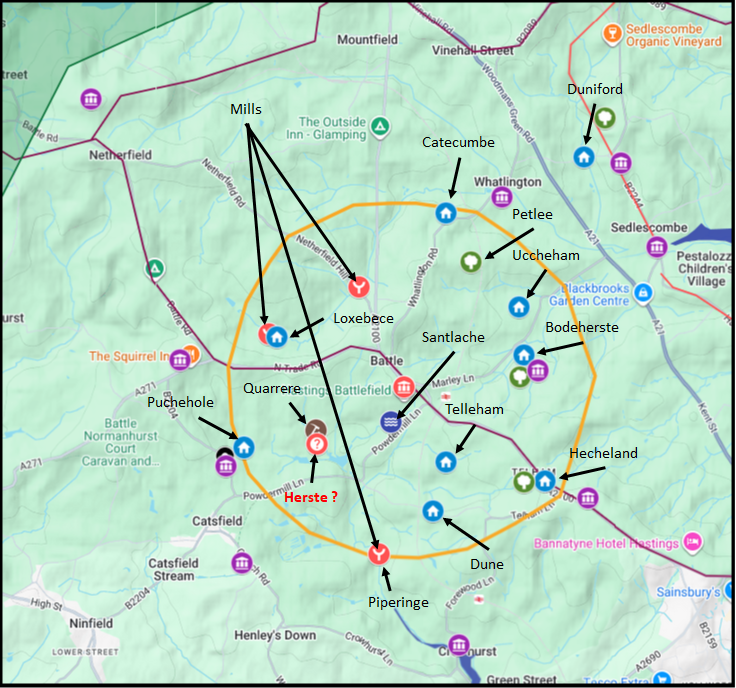|
 | Anglo Saxon History |  | |
| | Battle of Hastings 1066AD - P - Places named in the Chronicles |
|---|
|
| | |
|---|
| Senlac Hill ▲ |
|---|
We will start with Senlac Hill
| | Documentary evidence for Senlac ▲ |
|---|
By looking at the documents available from the time of the Battle, there is only one reference to Senlac which comes
from Orderic Vitalis(Gesta Normannorum Ducum) the relevent passage reads :
'The battle commenced at the third hour of the ides [14th] of October, and was fought desperately the whole day, with
the loss of many thousand men on both sides. The Norman duke drew up his light troops, consisting of archers and men
armed with cross-bows, in the first line ; the infantry in armour formed the second rank ; and in the third were placed
the cavalry, in the centre of which the duke stationed himself with the flower of his troops, so as to be able to issue
his commands, and give support to every part of the army. On the other side, the English troops, assembled from all
parts of the neighbourhood, took post at a place which was anciently called Senlac, many of them personally
devoted to the cause of Harold, and all to that of their country, which they were resolved to defend against the
foreigners. .'
He doesn't mention any hills, just the word Senlac.
|
The Hill from the Bayeux Tapestry ▲
|
|---|

There is no mention of the name Senlac in the Bayeux Tapestry, but a hill is shown.
The ground looks very uneven, either from man made ditches (see our
Malfosse page) or just implying broken ground.
|
Location of Senlac Hill ▲
|
|---|
 Senlac Hill is found inside Battle Abbey in the small town of Battle in East Sussex and is shown by the red dot on the
map below.
Senlac Hill is found inside Battle Abbey in the small town of Battle in East Sussex and is shown by the red dot on the
map below.
| | Senlac and the Victorians ▲ |
|---|
The name Senlac was introduced into English history by the Victorian historian E.A. Freeman who suggested that Senlac
meant Sand Lake in Old English with the Norman conquerors calling it (in French) Sanguelac('Blood
lake').
| | Possible Saxon derivations of Senlac ▲ |
|---|
The Victorians were looking at the name with limited data and there are other Saxon words this could be derived from so
lets look at these possible versions.
the saxon word lacu can translate to pool, pond or lake
The other naming possibilities are as follows:
segn lacu - this translates to 'Military Banner Lake'
It would seem unlikely that a place was named after a Military Banner unless after the
Battle.
segnian lacu - this translates to 'Making the sign of the cross Lake'
It would seem unlikely that a place was named this unless there was a church or monastery nearby and
in 1066AD this was empty land.
sand lacu - this translates to 'the Sandy Lake'
To the north of modern Senlac Hill there is a very steep valley with a spring that flows down into the Brede valley, the
nearest pond in that direction would have been towards Marley Lane a mile or so away but no reason to call it senlac as
marley means marl island(marl meaning clay).
Please be aware that a lot of ponds that are now in the area were caused by doodlebug explosions from World War 2
falling short of London, being shot down or being turned over by typhoon fighters.
It would seem unlikely that a place was called sand lake in an area which is mostly clay.
isen lacu - translates to 'Iron Lake or Iron pond'
To the south there is now the pond created at Powdermills, but originally this may have been created by the Romans
digging iron at Peppering eye a few hundred metres to the south east.
To the North West of the Battle Abbey lies the hamlet of Beech(now Beech Farm) which was in the Domesday Book and was an
iron working site that made cannons for the Royal Navy in the early 1700's.(please refer to the Wealden Iron Research Group's database )
It would seem quite possible that iron lake is the translation, however it could have been at
Pepperingeye near the Abbey, or towards Netherfield at Beech Farm
æscen lacu - translates as 'Ash tree Lake'
To the west towards Ashburnham we have an area known for its ash trees, and near to Ashburnham(Meaning the Stream in the
Ash trees)
there are a number of lakes, probably formed again for iron working , so there may be a second Senlac. Please see the
map below.
It would seem quite possible that ash tree lake is the translation, however this would mean the
Battle was near Netherfield, Ashburnham or Penhurst and not at Battle.
|
Possible alternative Saxon locations for Senlac ▲
|
|---|

The above map shows possible other Senlac Hills based on the local geography, please take a look at the above
details and make your own judgement on the location of the real Senlac.
The larger circles with names show the Domesday settlements in the area, the red lines are ancient Celtic ridgeways
that the Romans and Saxons used, the green shaded area shows the Forest of Andredsweald.
The shading of the settlements denotes the damage recorded in the Domesday Book, red denotes wasted, the yellow
denotes damaged and green undamaged settlements.
| | Conclusions for Senlac ▲ |
|---|
Please Note:
I am not trying to disclaim the current location of Senlac Hill, I am offering other translations which could imply
differing locations.
The Battle Abbey Chronicles make no mention of Senlac - that seems odd as its in the current Abbey Grounds.
Orderic Vitalis doesn't mention a hill in relation to the name, just at a place anciently called Senlac, which in turn
could imply a general area not a specific place, a bit like 'the Battle of Hastings' not being at Hastings, but in the
old Kingdom of Hastings.
| | Documentary evidence for Hecheland ▲ |
|---|
The Battle Abbey Chronicles make no mention of Senlac - that seems odd as its in the current Abbey Grounds, and
if the monks felt it was important they would surely have had a mention in the text. The Abbey Chronicles refer to the
nearby hill as Hecheland.
This is in the context of Duke William's forces
'Having arrived at a hill called Hecheland, situated in the direction of Hastings'
| | What does Hecheland mean ▲ |
|---|
To try to locate Hecheland we will see what this name could translate from.
the saxon word land can translate to LAND ⬩ earth ⬩ a land ⬩ country ⬩ region ⬩ district ⬩ province
⬩ land ⬩ landed property ⬩ estate ⬩ cultivated land ⬩ country, so a fair choice for translating.
If we look at Anglo Saxon words, there is no heche but a few other possibilities:
hecge - an enclosure, a fence, hedge
hecg - an enclosure, a fence, hedge
hege - an enclosure, a fence, hedge
hécen - a small goat
heáge - high
So we are looking for a hedged area, one where the goats are or a high area. These are not really helpful as we have no
reference to any of these in the local area.
We are also told it is towards Hastings, but have no reference as to the starting point.
| | Where is Hecheland ▲ |
|---|
There is no modern place named Hecheland
However we have an analysis of the lands of Battle abbey that shows its probable location, please click the button
below.
This map shows the majority of places named in the Leuga of the Abbey as recorded in the Battle Abbey Chronicles

| | |
|---|
| Conclusion for Hecheland ▲ |
|---|
Hecheland is mentioned regarding William's troops, so its implied that William's forces started at Telham hill.
If you analyse the Abbey Chronicles then the location has to be near to modern Telham on the Hastings ridge, which is
where they record that William prepared for the Battle of Hastings see The Lands of the Abbey from the Chronicles of Battle
Abbey for an analysis of the nearby locations.
| | Herst ▲ |
|---|
Now lets look at the place named Herst
| | Documentary evidence for Herst ▲ |
|---|
This place is referenced by the Battle Abbey Chronicles and would seem to be near the Quarry to the south east of the
Abbey, and a short distance from Powdermills.
|
This map shows the majority of places named in the Leuga of the Abbey as recorded in the Battle Abbey Chronicles

| | |
|---|
| Conclusion for Herste ▲ |
|---|
Herste is mentioned by the Monks of Battle Abbey as their preferential location for the siting of Battle Abbey, but
William instructed them to build the Abbey where Harold died see The Lands of the Abbey from the Chronicles of Battle
Abbey for an analysis of the nearby locations.
| | Conclusion ▲ |
|---|
If Senlac is derived from isenlacu then this would mean that the real Isenlac Hill would have been either at
Netherfield, as this was the point where the main ancient ridgeways (taken over by the Romans) from Rye and Hastings to
London joined or on the B2096 at Netherfield High Wood. These were both very close to the edge of the great Forest of
Andredsweald, which is recorded in some of the chronicles. And finally the B2096 is also known as Kane Hythe Road(Cyne
hyð rad) which can be translated from the Saxon as 'the starting point of the King'.
The location of Battle Abbey (St Martin of Tours)
Regarding the current placement of Battle Abbey, this was built 20 years after the Battle of Hastings (when the
majority of the participants had died), on a position well suited to the monks as it was on a hill, it had nearby water
and ponds for fish, and was built across the Hastings to London main road hence capturing all the traffic on that route.
If the abbey was not the actual location for the Battle of Hastings then this legend could have been created as a
counter to other monastries that had relics that pilgrims (tourists) would pay to see.
My personal belief is that if Senlac Hill is a valid reference to the Battle of Hastings then
Isenlac was the iron pond near to modern Beech Farm, this was called Beech in the Domesday book.
If this is the case then there is a distinct possibility that the Abbey Battle site is not the real site of the
Battle of Hastings, and that it is along Kame Hythe Road either at Netherfield High Wood, or at Netherfield
itself.
|
|
|
|
|
|
| |
|
|
Local Interest
Just click an image |
|
|
|
|
|
|
|
|
|
|
|
|
| |
|
|